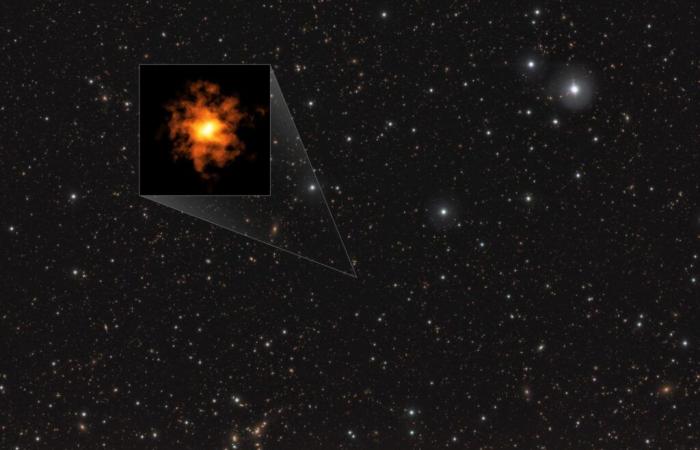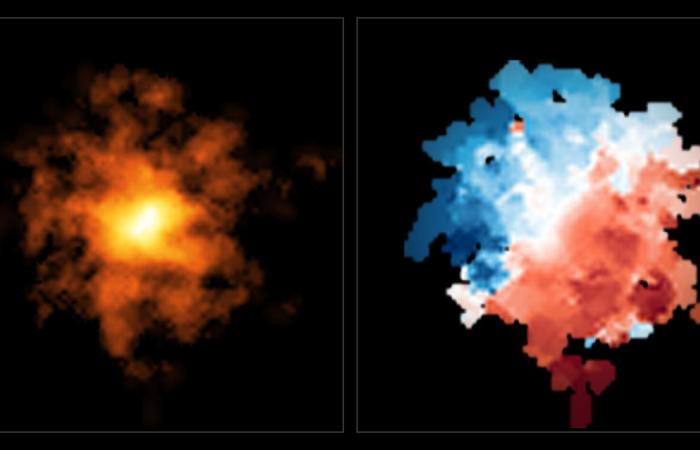It is flat, it turns on itself, it is very old and yet incredibly well ordered. A curiosity that intrigues astronomers.
In a recent study, researchers found evidence that REBELS-25 is a strongly rotating disk galaxy that may have existed for only 700 million years after the Big Bang. This makes it galaxy the most distant and earliest known to date, similar to the Milky Way.
Credit: ALMA (ESO/NAOJ/NRAO)/L. Rowland et al./ESO/J. Dunlop et al. Ack.: CASU, CALET
Researchers have discovered the most distant galaxy similar to the Milky Way ever observed. Named REBELS-25, this disk galaxy appears as ordered as current galaxies, but we see it as it was when the Universe was only 700 million years old. This is surprising because, based on our current understanding of galaxy formation, older galaxies should be more chaotic.
The rotation and structure of REBELS-25 were revealed thanks to ALMA (Atacama Large Millimeter/submillimeter Array), of which the European Southern Observatory (ESO) is a partner.
The galaxies we see today have evolved greatly from the chaotic, disordered galaxies that astronomers typically observed in the early days of the Universe. “Based on our understanding of galaxy formation, we expect most primitive galaxies to be small and disordered,” says Jacqueline Hodge, an astronomer at Leiden University in the Netherlands and co-author of the paper. ‘study.
These disordered primitive galaxies merge with each other and then evolve into smoother forms at an incredibly slow rate. Current theories suggest that for a galaxy to be as ordered as our Milky Way – a rotating disk with ordered structures like spiral arms – billions of years of evolution must have passed. The detection of REBELS-25 calls this time scale into question.
The left panel shows how cold gas is distributed in the galaxy, and shows evidence of an elongated bar structure at its center.
The right panel shows the movement of cold gas in the galaxy. The blue color indicates movement toward Earth and the red color indicates movement away from Earth, with a darker shade representing faster movement. In this case, the red-blue distribution of the image clearly shows that theobjet is rotating, making REBELS-25 the most distant rotating disk galaxy ever discovered.
Credit: ALMA (ESO/NAOJ/NRAO)/L. Rowland et al.
In this study, accepted for publication in Monthly Notices of the Royal Astronomical Society, astronomers discovered that REBELS-25 is the most distant strongly rotating disk galaxy ever discovered. The light reaching us from this galaxy was emitted when the Universe was only 700 million years old, barely 5% of its current age (13.8 billion), which makes the orderly rotation of REBELS -25 unexpected.
“Seeing a galaxy with such similarities to our Milky Way, which is strongly dominated by rotation, challenges our understanding of how quickly galaxies in the early Universe evolve into the ordered galaxies of today’s cosmos.” , explains Lucie Rowland, doctoral student at Leyden University and first author of the study.
REBELS-25 was initially detected in previous observations made by the same team, also with ALMA, which is located in the Atacama Desert in Chile. At the time, this was an exciting discovery, showing signs of rotation, but the resolution of data was not fine enough to be sure.
To properly discern the structure and motion of the galaxy, the team performed follow-up observations with ALMA at higher resolution, which helped confirm the record-breaking nature of the galaxy. “ALMA is the only existing telescope with the sensitivity and resolution to achieve this result,” explains Renske Smit, a researcher at Liverpool John Moores University, UK, and co-author of the study.
Surprisingly, the data also hints at more developed features similar to those of the Milky Way, such as an elongated central bar and even spiral arms, although further observations are needed to confirm this. “Finding further evidence of more evolved structures would be an exciting discovery, as this would be the most distant galaxy with such structures observed to date,” says Lucie Rowland.
These future observations of REBELS-25, along with other discoveries of early rotating galaxies, could transform our understanding of early galaxy formation and the evolution of the Universe as a whole.







